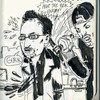Welcome back to Routine Moments in Baseball History, a running weekday feature that looks back at plays that have been ignored by the history books because history books only talk about things that are important or interesting. Today's installment is "Ron Oester Grinds Away." In recent photos, former Cincinnati Reds second baseman Ron Oester sort of resembles an old baseball: His head is round and shaved and scuffed by the years, an orb that took a split-fingered dive into the dirt too many times. He looks like you'd expect a guy who's spent his entire life on baseball fields and dugouts to look—gnarled, weather-beaten, a former athlete who filled out and hardened with the passage of the years. His Wikipedia page has an unsourced anecdote about how he didn't wear batting gloves so his palms blistered and cracked and bled; that's the kind of anecdote you want to believe about Oester. He played 13 seasons for the Reds, from 1978 to 1990, which were mostly hard years when the team finished second at best. He didn't have much power, he didn't steal many bases, but he found ways to get on base, he inspired the team's more talented stars with his work ethic, and he was a veteran leader on the 1990 World Series championship squad—the kind of player who'd get in someone's face if he needed it and stop fights when they needed to be stopped. By then he wasn't a starter anymore, but he got a couple of key postseason hits as a pinch hitter, then retired after finally getting a ring, a storybook ending for a man who was by then a grizzled baseball vet right out of central casting. "A quiet, efficient player who was always overlooked" was how Bill James described him, but Oester is getting some acknowledgement at last; he was just inducted into the Reds Hall of Fame this month.It's funny how careers like Oester's work. Looking back on him many writers have called him "hard-nosed" and some have bemoaned that he never got to manage the team he grew up rooting for and played for, but during the years he was holding down second base he wasn't highlight material. He was just sort of there, day in and day out, playing 150 or more games a season until he wasn't quite quick enough to field the position, then he was on the bench, then he was a coach—just like that, an entire generation had grown up with him in a Reds uniform, first as a frizzy-haired prospect, then as an everyday infielder whose presence in the lineup was as inevitable as the sun coming up.On August 25, 1986, Oester had already played over 900 games for the Reds. The blisters on his hands he acquired from all those years gripping the bat had turned to calluses, he had passed 30 and accepted that he was never going to quite become a star. He was doing his job out there in the hot Pittsburgh sun against the Pirates. He went 1 for 4 and played a decent game at second. In the bottom of the ninth, with the visiting Reds up 5-3, Pirates outfielder Bobby Bonilla hit a sharp chopper right to Oester. The second baseman secured it in his glove, paused for half a second to steady himself, then made the easy throw to first. Was it a particularly hard-nosed or inspiring play? No. Was it important? Not really, since the Reds would never catch the first-place Houston Astros. But it was an out, and you need 27 of them before everyone can go home.This has been Routine Moments in Baseball History. Follow Harry Cheadle on Twitter.
